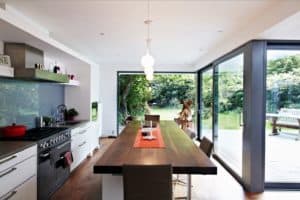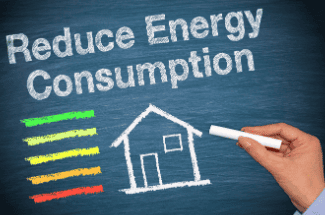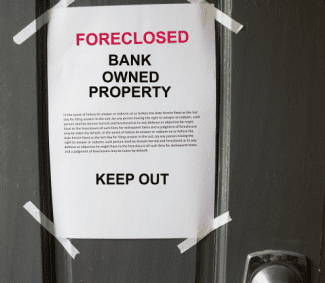The Top Kitchen and Bath Trends for 2018

Influenced by the home improvement television craze, farmhouse kitchens have finally overtaken traditional styles, according to the National Kitchen & Bath Association 2018 Design Trends Report released in January at the National Association of Home Builders International Builders Show. The report details what home remodelers, architects, dealers and manufacturers in the U.S. and Canada are specifying and building. Data was collected in August and September of last year.
Farmhouse style overtakes transitional, contemporary trends
Interior features common to farm and ranch houses have caught the eye of Americans while just edging out transitional and contemporary design trends. Elle H-Millard, NKBA’s industry relations manager and design trends expert, says home improvement television helped push the farmhouse style over the top after a long climb.
“The farmhouse is this very warm, cozy style that’s come about in the past few years,” she said. “Wood beams are a signature of that, as well as ship-lap and subway tiles.”
The trade isn’t being bashful about incorporating elements down on the farm into kitchens and baths. Sixty-nine percent are specifying barn door installations, according to the survey.
The shift to farmhouse designs is one of only a handful of changes in the last 12 months for the kitchen and bath market, which was estimated at $147.3 billion in 2016.
Induction cooking appliances gaining ground on gas
Some of the differences in the past year, Millard says, are movement away from kitchen islands that look like furniture and a retreat of the mid-century modern and industrial style. Also, even though gas cooking appliances are still king, popularity of induction ranges and cooktops are on the rise.
Sixty-seven percent of respondents said that induction cooking appliances are now trendy, a sign that home dwellers, especially Millennials, want healthier lifestyles, she said.
“I see induction cooking perhaps taking over the gas realm in the near future,” said Millard, a regular at the London Design Week. “I’ve spoken to many chefs that work for manufacturers and they use them personally in their homes. They have traded in gas appliances for induction. I really do see that moving forward. There are safety issues there, there are some things that induction is really taking the lead on, as well as being connected to our homes.
“We also may see a rise in steam cooking. There is nutritional value added when we have steam cooking in our homes, which then lends us to the next point which is wellness and freshness that’s included in some of our appliances. We’re looking at food preservation and how we can keep are food fresher for longer with less chemicals.”
Light colors, painted wood cabinets and quartz still dominate
Meanwhile, whites and grays continue to dominate walls, home buyers prefer painted cabinets (and wood is still popular), good lighting is important and quartz surfaces dominate granite.
The transformation from granite countertops to quartz continues, and it’s even creeping into the bathroom. Quartz is overwhelmingly the preferred surface with 94 percent of designers saying they are using it compared to granite (65 percent). Ninety-one percent say quartz is just as trendy in the bathroom.
Also, stainless steel, brushed nickel and chrome kitchen faucets are trending high, reinforcing Americans’ desire for light and neutral colors.
Elsewhere in the kitchen, column refrigeration units are gaining momentum. Also, 75 percent of respondents said that wine refrigerators are popular among home owners.
“The column refrigeration units are really taking a surge with being trendy in the industry,” Millard said. “There is more flexibility, more mobility. It gives designers more freedom to create a different aesthetic.”
Millard said microwave warming drawers, which can offer a dual purpose in outdoor spaces, are gaining momentum.
“Some people are using those to warm towels for swimming and other things,” she said. “We’re starting to see some unique developments with some of these appliances.”
Connectivity of kitchen, bath technology offers advantages
As far as technology, flat screen TVs, docking stations and distributed audio are still popular in the kitchen. It’s much the same in the bathroom but not as widespread. Only a small percentage of U.S. homeowners already have wall-mounted TVs in their bathrooms, lighting controls connected to their mobile devices or music in the shower.
Millard is unsure of the future of kitchen and bath technology but said connectivity offers definite safety advantages.
“You now have gas cooktops that are connected to you,” she said. “If you leave your burners on you get an alert on your phone. So now there is a safety issue that can be resolved, which can mean a reduction in insurance, etc. As long as technology is being used smart and not just to be for the sake of having some additional technology, I do see that as a big increase in the industry.”
Not unlike the kitchen, transitional and contemporary bathroom styles are preferred among U.S. homeowners. For the second consecutive year, traditional-style bathrooms ranked third.
For bathroom floors, the industry is leaning toward porcelain tile over ceramic tile and stone. Under-mount sinks are twice as popular as integrated vessel and trough sinks.
Also, free-standing bathtubs continue to be a favorite.
Millard says the industry may be on the cusp of a toilet revolution with more smart commodes available from manufacturers. Health is a factor.
“The smart toilet is something that is important. There is an infection reduction that can happen there. With universal design, you can help people save on money with their health insurance just based on pure infection, and they look awesome.”
Source: propertymanagementinsider.com















 Accessibility
Accessibility